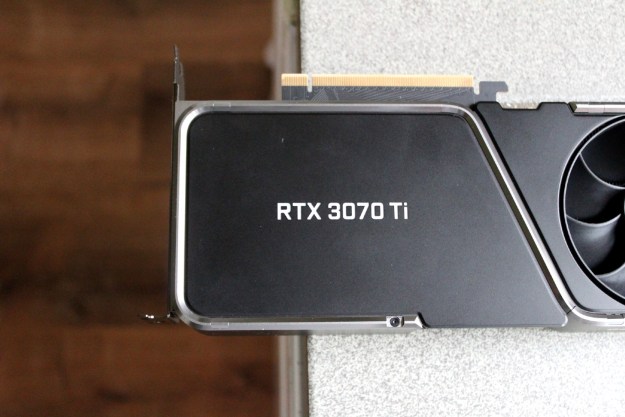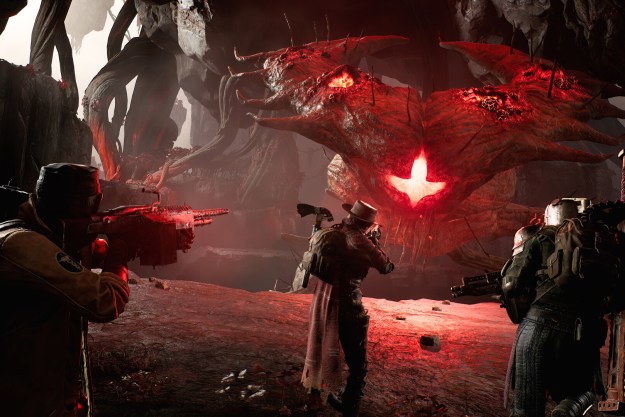Remnant 2 PC: change these graphics settings immediately
Remnant 2 is causing headaches for PC players already. Here are the best settings to optimize your performance in the game.

Remnant 2 is officially out after a three-day early access period, and PC players are already forming strong opinions. The game is remarkably demanding, despite the fact that it doesn’t include any ray tracing settings. On top of that, the developers insist that the game was designed with upscaling tools like Nvidia’s Deep Learning Super Sampling (DLSS) in mind, causing some backlash from PC players.
I’ve played just shy of 16 hours during the early access period, including a full campaign run. Although Remnant 2 is demanding even on flagship hardware, you can push down most of the graphics settings without impacting the look of the game. Here are the best settings to get Remnant 2 into a playable state on PC.
Best settings for Remnant 2 on PC
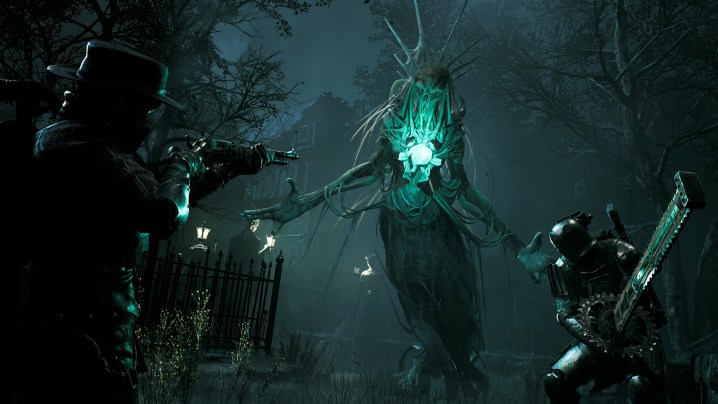 Gearbox
GearboxRemnant 2 has a small graphics settings menu, but they can make a big difference in performance. Here are the best settings I found after about 15 hours of gameplay:
Upscaler: DLSS — Balanced Shadow Quality: Low Post Processing: High Foliage Quality: High Effects Quality: Medium View Distance: HighThese are the exact settings I played through the game with, and that’s with an RTX 4090. You can push them so low because they have a very minor impact on visual quality, and in most scenes, you can’t tell the difference. Take the scene below. You get a little less sharpness with the optimized settings that DLSS easily makes up, but I’m struggling to see anything else that’s changed. There’s a touch less shadow on the rocks, but the sharpness is there across the scene and even the reflections look identical.
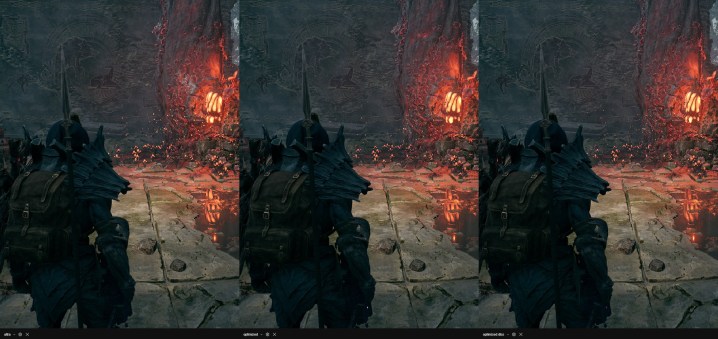
It’s not just this scene, either. As you can see in the dark scene below, taking the Shadow Quality all the way down to Low doesn’t impact the final image. The main difference is the tower in the back. With the Ultra preset, you can see the shadow of a town up the slope near the back of the image, which is absent from the Low preset. That’s an easy compromise to make, especially considering the performance improvements.
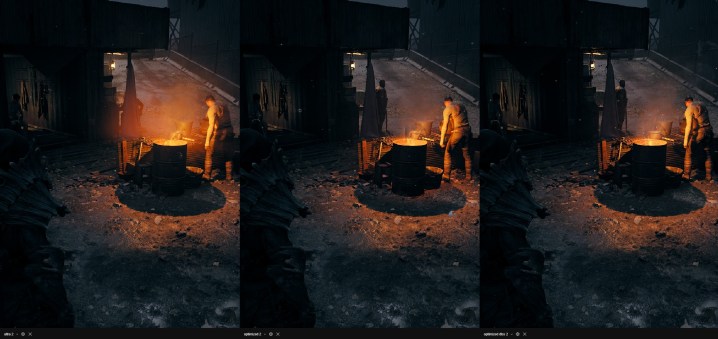
With the Ultra preset, I averaged 62 frames per second (fps) in Ward 13, which is far from the most demanding area in the game. At some points, even with an RTX 4090, I dipped down into the 40 fps territory. Optimized settings brought an average frame rate of 79 fps in Ward 13, and it’s hard to argue with a 27% boost in performance for basically no impact on image quality. And with DLSS set to Balanced, my average frame rate jumped up to 125 fps.
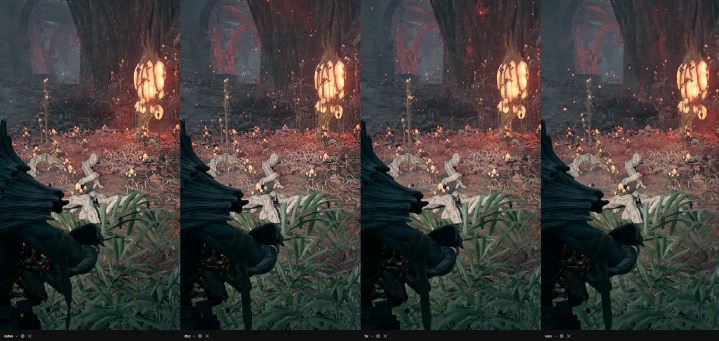
I recommend keeping DLSS on if you can. Unfortunately, it’s only available on Nvidia RTX graphics cards, so if you have something older or from AMD, you’ll need to use either AMD’s FidelityFX Super Resolution (FSR) or Intel’s XeSS. As you can see above, DLSS is definitely in the lead when it comes to image quality, but XeSS isn’t far behind. FSR is the only setting that majorly impacts image quality, making almost everything across the scene look softer.
Some problems that need addressing
Although you can boost your performance in Remnant 2 with the settings I’ve recommended, it’s hard to overlook the issues with the game’s PC performance at the moment. You clearly need an upscaler to hit a stable frame rate, even on high-end hardware, but the most pressing issue is the graphics menu. There are only five settings and they do very little.
That allows you to go all the way down to Low with a lot of the settings without impacting the final image much, but it also means there’s a very narrow performance window. The game desperately needs more graphics bandwidth to run on a wider range of hardware. The silver lining is that the game seems to overcome many of the shortfalls of Unreal Engine, which it’s built on. I saw proper CPU core scaling even on a Core i9-13900K and little in the way of shader compilation stutter. If the developer is able to flesh out the graphics menu more, this could be a very solid PC release.
 Gearbox
GearboxThere’s also the DLSS 3 issue. DLSS Frame Generation on RTX 40-series graphics cards can make even games like Warhammer 40K: Darktide playable, but it’s terrible in Remnant 2. If you turn on DLSS Frame Generation, you’re locked to 60 fps. Keep in mind the DLSS Frame Generation creates half of those frames, too, so the game feels like it’s running at 30 fps despite the fact that it looks like 60 fps. This is easily the worst showcase of DLSS 3 I’ve seen, and it may as well not be in the game.
The developers say they will roll out more performance updates in the coming weeks, and hopefully, those will include more graphics settings. They really should, as well. As we’ve written about previously, Remnant 2 has some of the best boss design we’ve seen in a shooter, and it would be a shame for that to go to waste due to poor performance.
Editors' Recommendations
Remnant 2 is a master class in great shooter boss fight design Ratchet & Clank to debut a revolutionary graphics tech on PC No one is buying new graphics cards right now It pains me to say, but it’s officially a bad time to be a PC gamer Surprise — Redfall on PC is yet another problematic portJacob Roach is a writer covering computing and gaming at Digital Trends. After realizing Crysis wouldn't run on a laptop, he…
Nvidia isn’t selling graphics cards — it’s selling DLSS
Nvidia does, of course, sell graphics cards. In fact, it sells most of the best graphics cards on the market. But more than ever before, the company is increasingly hanging its hat on its impressive Deep Learning Super Sampling (DLSS) to sell GPUs rather than raw performance.
The RTX 4090 stands as a crowning achievement in the world of consumer graphics cards, but once you get down into the cards that most gamers will actually buy, the generational improvements start to slip. This became abundantly clear with the launch of the RTX 4070. The card has been well-received, and I even awarded it a rare Editor's Choice award in my RTX 4070 review. But that's despite its generational improvements, not because of them.
The surprising reason your powerful PC still can’t handle the latest games
We're off to a rocky start with PC releases in 2023. Hogwarts Legacy, Resident Evil 4 Remake, Forspoken, and most recently and notably The Last of Us Part One have all launched in dire states, with crashes, hitches, and lower performance despite a minor increase in visual quality. And a big reason why is that the graphics cards of the last few years aren't equipped to handle the demands of games today.
The GPUs themselves are powerful enough; games haven't suddenly gotten more demanding for no reason. The problem is video memory or VRAM. Many of the most powerful GPUs from the previous generation weren't set up to handle the VRAM demands of modern games, which may explain why your relatively powerful PC can't handle the latest and most exciting new games.
What does your VRAM do anyway?
I tried 3 of Remnant 2’s classes and already have a clear favorite
When starting a new Soulslike game, I’m always faced with a make-or-break decision immediately: my class selection. There’s nothing worse than getting 20 hours into something like Elden Ring and realizing that the class I’ve chosen just doesn’t match my playstyle at all. So I’m glad that I’ve already sorted that out with Remnant 2, the upcoming sequel to Remnant: From the Ashes.
I went hands-on with the shooter at this year’s Game Developers Conference, trying out three classes as I attempted to gun down an ultra-tough boss. While I initially struggled to make a dent in my playthrough with my first two characters, I’d eventually wipe the floor with my enemies when I tried out the sequel’s new Handler class. Though, maybe that’s a little inaccurate: My cute, deadly dog companion did most of the heavy lifting. That experience has me much more intrigued by the Soulslike shooter, as a major overhaul to the original’s class system is already clicking with me.
New archetypes
Like its predecessor, Remnant 2 is a third-person shooter that draws inspiration from the Soulslike genre. You’ve got your high-difficulty, bonfire-like checkpoints, evasion rolls, and enormous bosses on the other side of foggy doors. The difference, though, is that the focus is on gunplay rather than close-ranged melee combat. Remnant 2 continues all of that, but the big change this time is in how it's handling character classes. While each archetype is still built around a specific set of weapons, they come loaded with more skills and perks that are gradually unlocked through a progression system.

 Hollif
Hollif 

